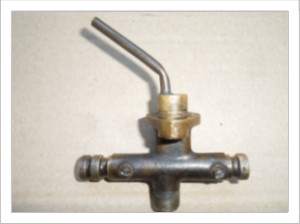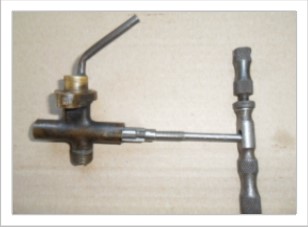 was a steady drip-drip of petrol from it.
was a steady drip-drip of petrol from it.LEAKING PETROL TAP
1930-1932 scuttle tank models with Ewarts tap
Tattybogle, my RN box saloon, had been plagued by a leaking petrol tap for
several months. No matter how many
times I dismantled, cleaned and
adjusted it, it persisted in leaking. I even tried wrapping the cork seals in
PTFE tape, as I had read somewhere this was a sure-fire way of sorting it out.
This worked for a bit but, after a while, the tape turned slimy and the leaks
re-started.
It was frustrating. I would think I
had fixed the problem when the tap held back a tankful of petrol overnight.
Then, when I operated the tap in the morning, it would not close off and there was a steady drip-drip of petrol from it.
was a steady drip-drip of petrol from it.
The construction of the tap can easily be seen in the ‘exploded photo’.
The tap is double-ended with main and reserve supply.
The main is fed from the tank by the short standpipe and the reserve by a
drilling in the brass body at the base of the main standpipe. There are main and
reserve tap plungers with cork seals which close off the appropriate drilling in
the tap body. These plungers are retained in the body by small set screws,
locating in slots along the plungers, which also act as limit stops.
Removing the tap from the car is a bit of a fiddle; first the fuel has to be
drained off, and then the tank mounting bolts removed to allow the tank to be
jiggled on the scuttle to give clearance to withdraw the tap from the hole in
the bulkhead.
Now, under strong light, I could see slight ridges in the bore of the main tap
worn by the cork seals over the past 75 years.
It now became clear to me that if the seal rested on a ridge in the
closed position, petrol could leak past it.
My previous attempts to adjust the tap would have resulted in the seal
being in a different position and probably resting on one of the ridges.

I was then alarmed to discover that new corks for this tap are not made.
There are some readily available for vintage motorcycles, which initially
appear the same, but are too large at 10.7 mm diameter.
I checked with the Seven Workshop and other suppliers who confirmed that
the correct corks are not available at present.
I obtained a reamer that
adjusted between 8.7 and 9.5 mm and carefully reamed out the bore in the tap
body with a series of very shallow cuts until all traces of the ridges were
removed and the bores were smooth and shiny. Then I reassembled the tap and
fitted it back in the car.
Unbelievably, despite checking I had ensured an air tight seal by blowing down
the tap with my mouth, it still leaked!
Once more I removed the tap and adjusted the seal shafts, and hallelujah,
it stopped leaking!
And, two weeks later, it is still not leaking!
Roger Bateman DA7C
*No longer available. However, top-rated eBay specialist Seal Supplies UK (sealsuppliesuk) are highly recommended from personal experience. Friendly, helpful and efficient. You need metric viton rubber FKM seals 9mm ID x 2.5mm cross-section. Search eBay for item 141455807142. A pack of ten ’o’ rings costs £4.35 with fast delivery.
ADDENDUM - Ewart Petrol Tap Screws.
When refirtting the petrol tap, I noticed neither retaining screws for the plungers were original and I had great difficulty in getting them out. Finally, I put the petrol tap in the deep freeze for 20 minutes and the final screw came out as easy as you please. Then came the job of trying to find replacement screws. After a long and tedious search I found GWR Fasteners website, and a wonderful selection of machine screws with a very helpful helpdesk. So I ordered 10 x 5BA brass, round headed, slotted machine screws for £4.44 inc postage. The smallest length they do is 3/8” so the screws needed cutting down. However, I am pleased to say they fit perfectly and I can’t wait to give everything a test run! Andrew Gossage DA7C